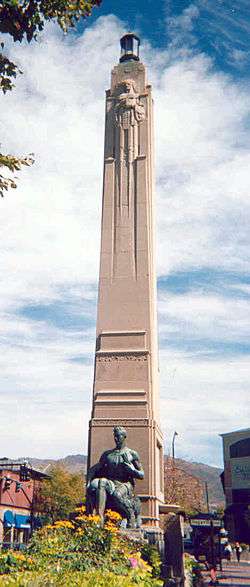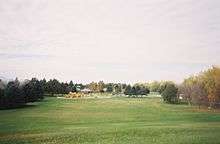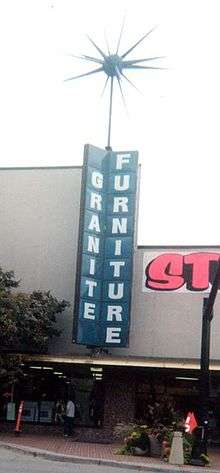Sugar House, Salt Lake City
- Sugar house also refers to a small building in which maple syrup is processed. For discussion of this, see Sugar house.

Sugar House is a neighborhood in Salt Lake City, Utah, United States. It is one of the city's oldest neighborhoods and the name is officially two words. Sugar House is the site of Westminster College.
Overview

Sugar House is home to two shopping centers that collectively feature various retailers such as Shopko, Toys "R" Us, bookseller Barnes & Noble, clothing retailer Old Navy, Whole Foods Market, Bed Bath & Beyond, Petco, several fast food and family restaurants, and a 10-screen Cinemark cinema. A strip mall is located on the corner of 2100 South and 700 East. The corner of 2100 South and 1300 East features three low-rise office buildings. Between the shopping center and 2100 South is a small park named Hidden Hollow Natural Area, created in 2001 as a development project to beautify the city in preparation for the 2002 Winter Olympics. It was rehabilitated based on the initiative of school children.[1] Sugar House Park is a park located between I-80, 2100 South, 1300 East, and 1700 East. The park is host to a large celebration with fireworks each July 4.
Location
Sugar House is located within the Salt Lake City grid system. According to the Community Council, it runs from 700 East to Foothill Drive and north to south from 1300 South to the city limits about 3000 South. According to Salt Lake City’s master plan, it runs from 700 East to Parleys Way and 2000 East and from 1700 South to the city limits about 3000 South.[2] Many local businesses as well as private residences, although not strictly located within the bounds of Sugar House, use the name because of the area's name recognition. The business and commercial center of the neighborhood is located at 1100 East 2100 South which is also the northern end terminus of Highland Drive, where it turns into 1100 East.
In the past, the Sugar House community council had mostly shunned big-box stores, and a cluster of curbside businesses existed along the intersection of 2100 South and Highland Drive/1100 East, including independent clothing and shoe stores, music shops, artist studios, public art galleries, two coffee shops, a head shop called Wizards & Dreams, and an adult interest store called Blue Boutique. However, recent redevelopment of the Granite Block have forced many of these stores to either relocate or close. Zoning changes have created concerns that the new development will be less friendly to local businesses.[3]
History

Sugar House was established in 1853, six years after Brigham Young led the Latter-Day Saint settlers into the valley. Its name derives from the sugar beet test factory of the Deseret Manufacturing Company, which was established in a former blacksmith shop in the area[4][5][6] with the assistance of Jersey-born convert Philip DeLaMare. The name came as a suggestion from Margaret McMeans Smoot, the wife of then mayor of Salt Lake City, Abraham O. Smoot.[7]
Sugar House Prison, the first Utah state prison, was located in Sugar House during the 19th century and early 20th century. The prison was closed in 1951 and moved to Draper. All of the buildings were torn down and the land was converted into Sugar House Park and Highland High School.[7] In 1928, at the dedication ceremony of the Sprague Library, Mayor John F. Bowman suggested Sugar House from then on be referred to as "South East Salt Lake City." This suggestion was rejected.

In the early 20th century, the corner of 1100 East and 2100 South was known as "furniture row" because three furniture stores were located there. Two have closed and one, Sterling Furniture, remains. Rockwood Furniture closed its doors in 1999 and Granite Furniture closed its Sugar House location in 2004, after more than 80 years of operation. (Granite Furniture still has a West Jordan store at 1475 West 9000 South.)
In 1990, the Sugar House Center shopping center was completed.[8] This brought large national chains to the area for the first time. In 1998 The Commons, a shopping center located just east of the town center ("Granite Block") and adjacent to the "Sugar House Center", was constructed in response to low patronage and has since been the target of both praise and criticism.[9]
Efforts began to establish a vintage style rail trolley to connect the Sugar House Business District to the TRAX station on 2100 South in South Salt Lake. In December 2006 the Utah Transit Authority, Salt Lake City, and South Salt Lake commissioned a Transportation Alternatives Study to examine transit possibilities on the Sugar House Branch of the old Denver and Rio Grande Western Railroad (D&RGW). The study determined that a trolley running along a pre-existing rail line was the preferred alternative. In May 2009, Mayor Ralph Becker stated that the project could be complete by 2012, will cost $40 million to $50 million, and that he hopes it is the beginning of a new streetcar system across the city.[10]
The S Line (formerly known as Sugar House Streetcar) began service on 8 December 2013 as planned,[11][12] and an extension of the line north along 1100 East to Westminster College has been approved.[13]
In September 2007, the owner of the Granite Block development on the corner of 1100 East and 2100 South, the site of many independent shops, announced plans to redevelop the area. In early 2008 the buildings on the eastern half of Granite Block were demolished in preparation for construction; Craig Mecham claims that the buildings were "not safe" due to their age.[14]
As a replacement, Mecham plans to construct two seven-story buildings, one with office space and one with condos, with ground-level retail. Residents and business owners in the area have shown disapproval of the plans and fear that redevelopment will prevent local businesses from thriving and that big business and chain stores will dominate on and off the court.[3] The fenced-off demolition site remains a scar-like crater and an ongoing source of controversy in the neighborhood.[15] The Great Recession has at least temporarily put a halt to the project.[16]
On December 1, 2010, developer Craig Mecham submitted an overhauled development plan for what had come to be derisively called the "Sugar Hole", eliminating the originally planned office space and replacing the condos with apartments. The street-level retail would remain as originally proposed.[15]
See also
S Line (formerly known as Sugar House Streetcar)
References
- ↑ Sugar Hill Council website; accessed August 6, 2014.
- ↑ Smart, Christopher (July 8, 2014). "People like living in Sugar House — even if they don't". The Salt Lake Tribune. Retrieved July 8, 2014.
- 1 2 Smeath, Doug (March 29, 2007). "Redevelopment worries Sugar House Residents ask City Council to save area's eclectic feel". Deseret News (Salt Lake City: Deseret Digital Media). Retrieved May 5, 2013.
- ↑ Taylor, Fred G. (1944). A Saga of Sugar. OCLC 1041958.
- ↑ Burton, Robert A.; Cox, Paul Alan (1998). "Sugarbeet Culture and Mormon Economic Development in the Intermountain West". Economic Botany (New York City: New York Botanical Garden Press) 52 (2): 201–206. doi:10.1007/bf02861211. JSTOR 4256061. OCLC 1567380.
- ↑ Godfrey, Matthew C. (2007). Religion, politics, and sugar: the Mormon Church, the federal government, and the Utah-Idaho Sugar Company, 1907-1921. Lehi, Utah: Utah State University Press. ISBN 0-87421-658-3. OCLC 74988178.
- 1 2 "Sugar House History & Information". Retrieved 5 May 2013..
- ↑ "For sale: Sugar House strip mall Dallas owner asking $27.5 million for plot by I-80 interchange". Deseret News (Salt Lake City: Deseret Digital Media). September 17, 1999. Retrieved May 5, 2013.
- ↑ "Goodbye, Sugar House". Archived from the original on 2006-10-26.
- ↑ Falk, Aaron (May 20, 2009). "Streetcars could roll in 3 years Becker says plans for $50M route to Sugar House on track". Deseret News (Salt Lake City: Deseret Digital Media). Retrieved May 5, 2013.
- ↑ Vo-Duc, Viviane (September 5, 2013). "New streetcar S-line set to open Dec. 8 in Sugar House". Deseret News. Salt Lake City: Deseret Digital Media. Retrieved September 17, 2013.
- ↑ "Salt Lake City welcomes S-Line". Railway Gazette International (Sutton, London: Railway Gazette Group). December 9, 2013. Retrieved April 9, 2014.
- ↑ Smart, Christopher (May 7, 2013). "City Council: Sugar House Streetcar will run on 1100 East". The Salt Lake Tribune (Salt Lake City: MediaNews Group). Retrieved August 5, 2013.
- ↑ Mitchell, Lesley (September 6, 2007). "Sugar House plans unveiled". The Salt Lake Tribune (Salt Lake City: MediaNews Group). Retrieved May 5, 2013.
- 1 2 Page, Jared (December 1, 2010). "Developer submits scaled-down 'Sugar Hole' plan". Deseret News (Salt Lake City: Deseret Digital Media). Retrieved May 5, 2013.
- ↑ Falk, Aaron (April 12, 2009). "Stalled projects: Salt Lake City". Deseret News (Salt Lake City: Deseret Digital Media). Retrieved May 5, 2013.
External links
| Wikimedia Commons has media related to Sugar House, Salt Lake City. |
- Sugar House Community Council - Website of the Sugar House Community Council.
Coordinates: 40°43′31″N 111°51′35″W / 40.725384°N 111.859618°W
| ||||||||||||||||||||||